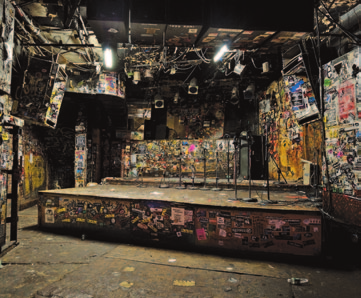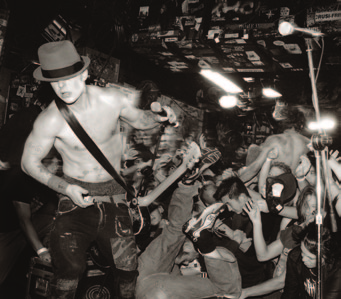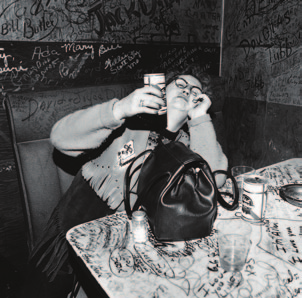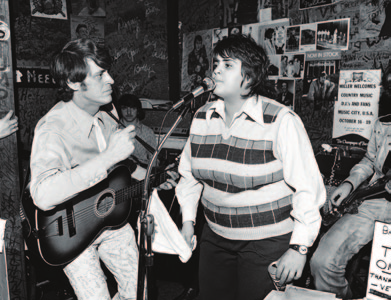How Music Works
Authors: David Byrne
Tags: #Science, #History, #Non-Fiction, #Music, #Art

h o w
m u s i c
w o r k s
How
Music
Works
David Byrne
McSweeney’s
M c S W E E N E Y ’ S
sa n f r a n c i s c o
www.mcsweeneys.net
Copyright © 2012 David Byrne
Cover design by Dave Eggers
All rights reserved, including right of reproduction
in whole or part in any form.
McSweeney’s and colophon are registered trademarks of McSweeney’s,
a privately held company with wildy fluctuating resources.
Some of these chapters first came to life in other forms. “Creation in Reverse”
began as a TED talk; “How To Make a Scene” began as an introduction to a picture book about CBGB; “Business and Finances” includes material from an article that originally ran in
Wired
magazine. Those pieces have been extensively revised and expanded. Thank you to the editors who first motivated me to write them. —DB
ISBN: 978-1-936365-53-1
Printed in China by Shanghai Offset Printing.
To Emma and Tom Byrne, who put up with
my adolescent musical expressions and
even helped out from time to time.
c o n t e n t s
c o n t e n t s
9
13
Creation in Reverse
31
My Life in Performance
75
Technology Shapes Music: Analog
117
Technology Shapes Music: Digital
139
In the Recording Studio
183
Collaborations
203
Business and Finances
251
How to Make a Scene
267
Amateurs!
301
Harmonia Mundi
335
Acknowledgments
336
Notes
342
Suggested Reading
345
Illustration Credits
347
About the Author
p r e f a c e
p r e f a c e
I’ve been involved in music all my adult life. I didn’t plan it that way,
and it wasn’t even a serious ambition at first, but that’s the way it
turned out. A very happy accident, if you ask me. It’s a little strange,
though, to realize that a large part of my identity is tied to something
that is completely ephemeral. You can’t touch music—it exists only at
the moment it is being apprehended—and yet it can profoundly alter how we
view the world and our place in it. Music can get us through difficult patches in our lives by changing not only how we feel about ourselves, but also how
we feel about everything outside ourselves. It’s powerful stuff.
Early on, though, I realized that the same music placed in a different con-
text can not only change the way a listener perceives that music, but it can also cause the music itself to take on an entirely new meaning. Depending on where you hear it—in a concert hall or on the street—or what the intention
is, the same piece of music could either be an annoying intrusion, abrasive
and assaulting, or you could find yourself dancing to it. How music works,
or doesn’t work, is determined not just by what it is in isolation (if such a condition can ever be said to exist) but in large part by what surrounds it, where you hear it and when you hear it. How it’s performed, how it’s sold and distributed, how it’s recorded, who performs it, whom you hear it with, and, of course, finally, what it sounds like: these are the things that determine not only if a piece of music works—if it successfully achieves what it sets out to accomplish—but what it
is
.
Each chapter in this book focuses on a distinct aspect of music and its
context. One asks how technology has affected the way music sounds and the
way we think of it. Another considers the influence of the places in which
we listen to it. The chapters are not chronological or sequential. You can read them in any order, though I do think the order my editors and I arrived at has a flow to it—it isn’t entirely random.
This is not an autobiographical account of my life as a singer and musician, but much of my understanding of music has certainly been accrued over many
DAV I D BY R N E | 9
years of recording and performing. In this book I draw on that experience to illustrate changes in technology and in my own thinking about what music and performance are about. Many of my ideas about what it means to go on stage,
for instance, have changed completely over the years, and my own history of
performance is a way of telling the story of a still-evolving philosophy.
Others have written insightfully about music’s physiological and neuro-
logical effects; scientists have begun to peek under the hood to examine the precise mechanisms by which music works on our emotions and perceptions.
But that’s not really my brief here; I have focused on how music might be
molded
before
it gets to us, what determines if it gets to us at all, and what factors external to the music itself can make it resonate for us. Is there a bar near the stage? Can you put it in your pocket? Do girls like it? Is it affordable?
I have, for the most part, avoided the ideological aspects of music mak-
ing and production. That music can be made to bolster nationalistic urges or written in the service of rebellion and overthrowing an established culture—
whether the motive is political or generational—those are beyond the scope
of this book. I’m not much interested in specific styles and genres either, as it seems to me that certain models and modes of behavior often recur across
wildly different scenes. I hope that you will find something to enjoy here even if you have no interest in my own music. I’m also uninterested in the swollen egos that drive some artists, although the psychological make-up of musicians and composers shapes music at least as much as any of the phenomena
I’m fascinated by. I have rather looked for patterns in how music is written, recorded, distributed, and received—and then asked myself if the forces that fashioned and shaped these patterns have guided my own work… and maybe
the work of others as well. One hopes I’m not just talking about myself here!
In most cases the answer is yes; I’m no different than anyone else.
Does asking oneself these questions in an attempt to see how the machine
works spoil the enjoyment? It hasn’t for me. Music isn’t fragile. Knowing how the body works doesn’t take away from the pleasure of living. Music has been around as long as people have formed communities. It’s not going to go away, but its uses and meaning evolve. I am moved by more music now than I have
ever been. Trying to see it from a wider and deeper perspective only makes it clear that the lake itself is wider and deeper than we thought.
10 | HOW MUSIC WORKS
h o w
m u s i c
w o r k s
c h a p t e r o n e
Creation in
Reverse
c h a p t e r o n e
Creation in
Reverse
Ihad an extremely slow-dawning insight about creation. That insight
is that context largely determines what is written, painted, sculpted,
sung, or performed. That doesn’t sound like much of an insight, but
it’s actually the opposite of conventional wisdom, which maintains
that creation emerges out of some interior emotion, from an upwelling
of passion or feeling, and that the creative urge will brook no accommodation, that it simply must find an outlet to be heard, read, or seen. The accepted
narrative suggests that a classical composer gets a strange look in his or her eye and begins furiously scribbling a fully realized composition that couldn’t exist in any other form. Or that the rock-and-roll singer is driven by desire and demons, and out bursts this amazing, perfectly shaped song that had to
be three minutes and twelve seconds—nothing more, nothing less. This is
the romantic notion of how creative work comes to be, but I think the path of creation is almost 180º from this model. I believe that we unconsciously and instinctively make work to fit preexisting formats.
Of course, passion can still be present. Just because the form that one’s
work will take is predetermined and opportunistic (meaning one makes
something because the opportunity is there), it doesn’t mean that creation
must be cold, mechanical, and heartless. Dark and emotional materials usu-
ally find a way in, and the tailoring process—form being tailored to fit a given DAV I D BY R N E | 13


context—is largely unconscious, instinctive. We usually don’t even notice
it. Opportunity and availability are often the mother of invention. The emo-
tional story—“
something to get off my chest
”—still gets told, but its form is guided by prior contextual restrictions. I’m proposing that this is not entirely the bad thing one might expect it to be. Thank goodness, for example, that we don’t have to reinvent the wheel every time we make something.
In a sense, we work backward, either consciously or unconsciously, creating
work that fits the venue available to us. That holds true for the other arts as well: pictures are created that fit and look good on white walls in galleries just as music is written that sounds good either in a dance club or a symphony hall (but probably not in both). In a sense, the space, the platform, and the software
“makes” the art, the music, or whatever. After something succeeds, more ven-
ues of a similar size and shape are built to accommodate more production of
the same. After a while the form of the work that predominates in these spaces is taken for granted—
of course
we mainly hear symphonies in symphony halls.
In the photo below you can see the room at CBGB where some of the music
I wrote was first heard.A Try to ignore the lovely décor and think of the size and shape of the space. Next to that is a band performing.B The sound in that club was remarkably good—the amount of crap scattered everywhere, the
furniture, the bar, the crooked uneven walls and looming ceiling made for
both great sound absorption and uneven acoustic reflections—qualities one
might spend a fortune to recreate in a recording studio. Well, these qualities were great for this particular music. Because of the lack of reverberation,
one could be fairly certain, for example, that details of one’s music would
A
B


